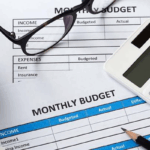Many people believe that investing requires a big bank balance or professional financial knowledge — but that’s no longer true. Thanks to modern technology, online platforms, and innovative financial tools, anyone can start investing with just a few dollars.
If you’ve ever wondered how to start investing with little money in 2025, this guide will walk you through everything — from simple strategies to smart tools that make investing easy and rewarding, even on a small budget.
Why You Should Start Investing Now
In 2025, the global financial landscape is more digital, accessible, and transparent than ever before. The earlier you start investing, the more you can take advantage of compound growth, which means your earnings generate even more earnings over time.
Even small investments made consistently can grow significantly in a few years. For example, investing just $25 a month in an ETF (Exchange Traded Fund) earning 8% annually can grow to over $3,600 in 10 years.
So, even if your budget is tight, starting small gives your money time to work for you.
Step 1: Set Clear Financial Goals
Before investing, ask yourself: What am I investing for?
Your goals will shape your investment choices and risk tolerance.
Common goals include:
- Saving for retirement
- Building an emergency fund
- Paying for education
- Buying a home
- Earning passive income
If your goals are short-term (like buying a car), consider low-risk investments such as savings accounts or short-term bonds.
If they’re long-term (like retirement), you can consider higher-risk, higher-return options such as stocks or ETFs.
Step 2: Build a Small Safety Net First
Before you start investing, make sure you have a small emergency fund — ideally, enough to cover 3–6 months of expenses.
This gives you peace of mind and prevents you from selling your investments early during emergencies. You can start by saving in a high-yield savings account that offers decent interest and liquidity.
Step 3: Choose the Right Investment Platform
In 2025, investing platforms are designed to help beginners start small. You don’t need a traditional broker anymore — all you need is a smartphone and a few dollars.
Here are some popular types of platforms:
| Platform Type | Example Use | Investment Minimum |
|---|---|---|
| Micro-Investing Apps | Apps like Acorns or Stash invest spare change automatically. | As low as $5 |
| Robo-Advisors | Automated investing tools like Betterment or Wealthfront manage your portfolio for you. | Around $10–$50 |
| Commission-Free Brokers | Platforms like Robinhood, Webull, or eToro let you buy fractional shares. | $1 or less |
| Crypto Investment Platforms | Coinbase or Binance let you invest in cryptocurrencies with small amounts. | $10–$20 |
Choose a platform that matches your goals, has low fees, and offers user-friendly tools.
Step 4: Start with Fractional Shares
One of the best things about investing in 2025 is the ability to buy fractional shares — meaning you can buy part of a stock instead of a full share.
For example, if one share of Tesla costs $300, you can invest just $5 or $10 and still own a small piece of it.
This makes it possible for anyone to build a diversified portfolio with very little money.
Step 5: Diversify Your Portfolio
Diversification means spreading your investments across different assets to reduce risk.
Instead of putting all your money into one company, consider investing in:
- ETFs (which track groups of companies)
- Mutual funds (professionally managed portfolios)
- Bonds (safer investments with fixed returns)
- Real estate REITs (property-based investments)
- Crypto or digital assets (higher risk but high potential)
A simple beginner-friendly rule is the “70-20-10” strategy:
- 70% in diversified ETFs
- 20% in individual stocks or funds you believe in
- 10% in higher-risk assets like crypto
This approach balances growth and safety.
Step 6: Automate Your Investments
Automation helps you stay consistent, even when life gets busy.
Most investing apps allow auto-investing — meaning a fixed amount is invested every week or month automatically.
This not only removes emotional decision-making but also takes advantage of dollar-cost averaging, which smooths out price fluctuations by investing regularly, no matter the market condition.
Step 7: Keep Learning and Stay Patient
Investing isn’t about getting rich overnight — it’s about building wealth slowly and steadily.
Make a habit of learning. Follow trusted financial blogs, YouTube channels, or courses on personal finance.
Avoid trends that promise quick profits — these are often high-risk and short-lived.
The key is patience. Even if you start with $10, staying consistent can lead to great results over time.
Step 8: Reinvest Your Earnings
When your investments earn dividends or profits, reinvest them instead of cashing out. This accelerates compound growth.
Most platforms offer automatic dividend reinvestment options, allowing your money to keep working without extra effort.
Step 9: Review and Adjust Regularly
As you grow financially, your goals or risk tolerance might change. Make sure to review your portfolio at least once or twice a year.
You may want to move from higher-risk assets to more stable options as you get closer to your goals.
This process is called rebalancing — it helps maintain a healthy investment mix over time.
Step 10: Stay Consistent — Even in Small Steps
The biggest secret to successful investing is consistency.
It doesn’t matter if you invest $10, $50, or $100 per month — what matters is that you keep going.
In 2025, opportunities are endless, and access to tools is easier than ever. Your financial future depends not on how much you start with, but that you start at all.
Quick Beginner’s Investment Plan (Example)
| Month | Investment Type | Amount | Goal |
|---|---|---|---|
| January | ETF (Index Fund) | $20 | Long-term growth |
| February | Fractional Stock | $10 | Build exposure |
| March | REIT | $15 | Real estate diversification |
| April | Crypto (Bitcoin/Ethereum) | $10 | High-risk/high-reward |
| May | Bond Fund | $15 | Stability |
| Total (5 months) | — | $70 | Diversified portfolio |
As you can see, even with less than $100, you can begin a balanced investment journey.
Final Thoughts
Starting to invest with little money in 2025 is not only possible — it’s smarter than ever. The world of finance has become more inclusive, digital, and beginner-friendly.
Don’t wait for “someday” when you have more money. Start small, stay consistent, and watch your money grow over time. Every dollar invested today brings you one step closer to financial freedom.
FAQs About How to Start Investing with Little Money in 2025
1. Can I really invest with just $10 or $20?
Yes! Many modern platforms allow investments starting as low as $1. You can buy fractional shares or invest in ETFs without needing a large sum.
2. What’s the safest investment for beginners?
Low-cost index funds, ETFs, and government bonds are considered safer choices for beginners since they offer stable returns with less risk.
3. Should I pay off debt before investing?
If you have high-interest debt (like credit card debt), it’s better to pay it off first. But if your debt has a low interest rate, you can start investing small amounts alongside debt repayment.
4. Is cryptocurrency a good investment for beginners?
Crypto can be part of your portfolio, but it’s highly volatile. Start with a small percentage (5–10%) and only invest what you can afford to lose.
5. How long should I keep my investments?
It depends on your goals. For long-term goals like retirement, keep your investments for 5–10 years or more to maximize compound growth and ride out market fluctuations.
In summary:
You don’t need thousands of dollars to start investing — you just need commitment, discipline, and a willingness to learn. With the right mindset and the right tools, 2025 can be the year you build your financial foundation, no matter your income level.











